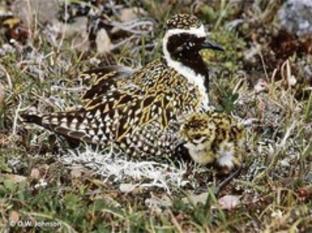Published in the Ocean Watch column, Honolulu Star-Advertiser © Susan Scott
April 23, 2012
While walking my dog last week, I saw a male kolea prance across our path. The bird was at the top of its game, so fat and fabulous in its spring breeding outfit that I had to stop and stare.
 Courtesy O.W. Johnson
Courtesy O.W. Johnson
A male kolea in Alaska tends to one of his chicks.
Watching the unafraid plover pluck bugs from my sidewalk made me a little teary. How lucky we Hawaii residents are that these migratory shorebirds have learned to live with us and that we in turn get to host them practically as pets in our driveways, yards and parks. It’s a rare case of wildlife in urban areas being a win-win for both species.
‘Twas not always so. In ancient Hawaii plovers were a food source. Men, women and children caught the birds with snares tied to palm-size rocks called kolea stones. A thin groove ran down the center of each stone. The hunter tied one end of a string around the groove and the other end to a narrow bone sharpened at both ends with a grub skewered onto it. When the plover swallowed the bone, it lodged sideways in the throat, and the bird was toast.
Late in the 19th century, plovers were a popular topping for toast. “Plovers on toast” was featured on both breakfast and dinner menus at Iolani Palace.
In the early 20th century, Hawaii hunters shot plovers with abandon until the government imposed a limit of 15 plovers per hunter per day. Still, the kolea were overcome, and in 1941 Hawaii banned all plover hunting. Today all migratory shorebirds (and seabirds) are protected by state and federal laws.
Since they gained protection, plovers have gradually increased in number in the islands. No one knows their pre-human population, but researchers speculate that plover numbers in Hawaii today might be higher than they ever were.
Plovers know a good thing when they see it: mowed lawns and tons of introduced insects, lizards and berries. To get the goodies, all the birds had to do was share the space with humans. The smart kolea adapted.
Since they return to the same spot each year, some plovers recognize their hosts and have learned to eat from friendly human hands. Researchers report that on the tundra when raising chicks, those same birds are skittish and wary. Fortunately for us admirers, the birds become tame again in Hawaii.
Because plovers head north in flocks each year on or near April 25, it’s time to say goodbye and good luck to our living lawn ornaments. When they leave Hawaii this week, the birds will fly to their arctic breeding grounds about 2,800 miles away in three days, nonstop.
I know thousands of Hawaii residents will join me in feeling a little lonely after the kolea have gone. There’s joy, though, in knowing they’ll be back.